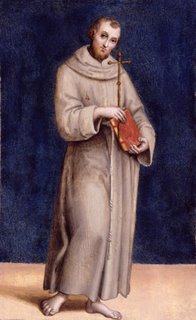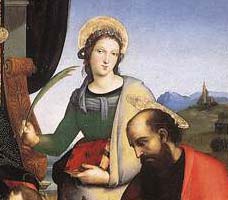Ionarts in New York: Colonna Altarpiece at the Met
 If I go to the Metropolitan Museum of Art for a very brief visit, as I did on Saturday afternoon for a drive-by look after lingering at the Pierpont Morgan Library, I really do not feel guilty about not paying full price. Before getting a quick dinner and heading to a concert, I had only enough time to see two things there: Cai Guo-Qiang's rooftop installation, Transparent Monument (it was closed due to inclement weather) and the reunited Colonna Altarpiece by Raphael. Once again, the quick eye and deep pockets of J. Pierpont Morgan made this possible, since it was he who purchased the main panel and lunette of this altarpiece, the last one in a private collection, in 1901, later donating it to the Met. Of the four small panels of the predella, or base, of the altarpiece, the Met later was able to acquire only one. This exhibit reunites the Met's three pieces with the remaining pieces, from three different institutions, for the first time since the altarpiece was taken apart in 1663.
If I go to the Metropolitan Museum of Art for a very brief visit, as I did on Saturday afternoon for a drive-by look after lingering at the Pierpont Morgan Library, I really do not feel guilty about not paying full price. Before getting a quick dinner and heading to a concert, I had only enough time to see two things there: Cai Guo-Qiang's rooftop installation, Transparent Monument (it was closed due to inclement weather) and the reunited Colonna Altarpiece by Raphael. Once again, the quick eye and deep pockets of J. Pierpont Morgan made this possible, since it was he who purchased the main panel and lunette of this altarpiece, the last one in a private collection, in 1901, later donating it to the Met. Of the four small panels of the predella, or base, of the altarpiece, the Met later was able to acquire only one. This exhibit reunites the Met's three pieces with the remaining pieces, from three different institutions, for the first time since the altarpiece was taken apart in 1663.
The altarpiece gets its name from a family of art collectors in Rome, who owned the work after a celebrity list of European nobility, including Queen Christina of Sweden and the Duc d'Orlèans. It should be named instead for its original location, the nuns' choir, the cloistered section of a convent church, of Sant'Antonio di Padova in Perugia. At this point -- the Colonna altarpiece was completed in 1504 and 1505 -- Raphael had been apprenticed to Perugino in Perugia for about ten years and was looking to move on. For an audience of nuns at their communal prayers, Raphael was notably conservative in many ways, using gold for shining Byzantine halos, for example, something he would do away with for the most part when he was on his own in Florence and Rome.
 Agony in the Garden Metropolitan Museum of Art |  Pietà Isabella Stewart Gardiner Museum, Boston |
The wall text in the exhibit has some photographs of the church, in its present, heavily altered form, but one can still gain a good idea of how the altarpiece was originally placed. The greatest revelation of that placement is that the striking shadows in the main panel -- cast especially by St. Paul, as well as by the foot of the Virgin Mary, which hangs over the edge of her dais just slightly, and the point of St. Paul's sword, details that are visible best in person -- correspond to where the natural light of the chapel entered through a window. The effect, as in so much religious art of the period, was to make the sacred characters of the altarpiece be as real a part of the prayer experience of the nuns as possible. Because all the pieces are together, you can even see the same orientation of shadows in all of the predella panels.
 Saint Francis of Assisi Dulwich Picture Gallery |  Saint Anthony of Padua Dulwich Picture Gallery |
Several reviews of this exhibit have criticized the placement of the show, in a rather ordinary room and with the component parts of the work spread apart instead of reassembled in their original form. I can understand the impulse toward reconstruction, which is how the Met normally shows the lunette and main panel, in a wood frame. However, since the gilt frame that originally housed the panels was destroyed, and it is impossible to view the whole work in its original context, I was happy to get to examine each part individually and very close up, which one cannot do with the crowning lunette as the Met normally shows it.
 Procession to Calvary National Gallery of Art, London |
The smaller panels were executed earlier than the main panel and lunette, and they have a less detailed, more cartoonish style, although the bright colors of the central predella panel, showing the carrying of the cross, are extraordinary and luminous. The one question left unanswered by this exhibit was the identity of the female saint on the right of the Virgin Mary in the main panel. We clearly have Mary, Jesus, and the young John the Baptist on the dais. In the foreground are two male saints easily identified by their iconographic symbols: St. Peter (left), with the key given to him by Jesus, and St. Paul (right), with the sword that made him a martyr. In the background, the female saint on the left is clearly Catherine of Alexandria, whose martyrdom is indicated by the palm carried in her hand and by the wheel used to torture her. The nuns of this particular convent were Franciscans, and the leading male saints of their order, Francis and Anthony, were depicted on the predella. But who is the other female saint in the main panel, to the right of the Virgin Mary?
 I have seen her identified as Lucy or Cecilia, but never with certainty. We can be sure that she is a martyr, since she also holds the palm of victory, just like Catherine. We have apparently two symbols found with her in this painting: a book in her other hand and a crown of flowers in her hair. Flowers are a symbol for more than one virgin martyr, including Dorothy and Elizabeth of Hungary. The latter is a common Franciscan saint. Cecilia's legend recounts that both she and her husband, Valerian (whom she converted to Christianity before their marriage was consummated), were both given crowns of flowers by angels from heaven. That may be why some historians have argued for Cecilia. Of course, by this point in history, she was most often identified with a musical instrument, the easiest way to distinguish her from Dorothy, who shares many of the same iconographic symbols.
I have seen her identified as Lucy or Cecilia, but never with certainty. We can be sure that she is a martyr, since she also holds the palm of victory, just like Catherine. We have apparently two symbols found with her in this painting: a book in her other hand and a crown of flowers in her hair. Flowers are a symbol for more than one virgin martyr, including Dorothy and Elizabeth of Hungary. The latter is a common Franciscan saint. Cecilia's legend recounts that both she and her husband, Valerian (whom she converted to Christianity before their marriage was consummated), were both given crowns of flowers by angels from heaven. That may be why some historians have argued for Cecilia. Of course, by this point in history, she was most often identified with a musical instrument, the easiest way to distinguish her from Dorothy, who shares many of the same iconographic symbols.What if there were actually a third symbol in the background, where there is a building with a tower? (Significantly, the landscape is empty behind Catherine on the other side.) The tower is an important and almost exclusive symbol for Saint Barbara, because her father kept her locked up in a tower. A book and crown of flowers have been associated with Barbara, who is not infrequently paired with Catherine of Alexandria. For example, see Hans Memling's Virgin and Child with Saints Catherine of Alexandria and Barbara (1479, also in the Met), where Catherine is on Mary's left and Barbara is on the right, reading a book and with a tower in the background behind her. Catherine and Barbara are both saints who preferred the Christian faith over an arranged marriage and faced pain and death for their belief, making them models for religious sisters. (In France, you still sometimes hear the term une catherinette for a woman who is unmarried by the age of 25: by tradition, she must wear a funny hat and pray hard for a husband on La Sainte Catherine, November 25.) We would welcome any thoughts from art historians who might be reading about my theory of Saint Barbara in the Colonna altarpiece. Maybe you can also tell me what the baby Jesus is wearing and holding in his hand in this painting.
The reunited altarpiece is accompanied by a couple rooms of sketches and a painting or two by Raphael, as well as works by Perugino and other contemporaries. It is all put together well, but the reason to go is to see all the panels up close and personal. You can do so until September 4.




















































2 comments:
Nice post, very thorough. i need to build a tower.
Thanks, Mark! You know, the man who built the tower ended up killing his own daughter, so maybe you should rethink that plan. ;-)
Post a Comment